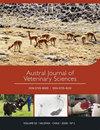Fascioliasis prevalence in livestock from abattoirs in southern Chile
IF 0.8
4区 农林科学
Q3 VETERINARY SCIENCES
引用次数: 1
Abstract
Fascioliasis is a widely distributed parasitic zoonosis caused by the trematode Fasciola hepatica that affects livestock production and generates high economic losses. In Chilean authorised abattoirs, the infected livestock livers are condemned during the veterinary inspection. This study aims to evaluate the prevalence of fascioliasis in Chile from 2014 to 2016 and also monthly from 2002 to 2015 in livestock (cattle, pig, sheep, horse and goat) slaughtered in abattoirs of La Araucanía region, southern Chile. To do this, the available records on abattoirs provided by the sanitary authority were analysed. A descriptive statistics and trend analysis of the data by jointpoint regression was carried out. The Biobío and La Araucanía regions registered the highest levels of parasitosis in the country recording levels of 59.18 and 44.74%, respectively, and presented 50.03% of the liver condemnation rate in cattle. During the study period, a total of 2,239,164 animals were slaughtered and 40.59% infected livers with F. hepatica were condemned in the 9 existing abattoirs of La Araucanía region. The abattoirs located in the cities of Temuco (51.43%) and Angol (65.09%) recorded the highest percentages of fascioliasis. The cattle species recorded the highest number of slaughtered animals and liver condemnation (54.52%). The presence of the parasite was recorded annually and monthly and it was possible to observe a slight increase in fascioliasis over the years. This study provides updated information on the fascioliasis prevalence in the country and the dynamics of condemnation in endemic areas such as La Araucanía region, which could contribute to the control and prevention of this zoonosis.智利南部屠宰场牲畜中片形吸虫病流行情况
片形吸虫病是由肝片形吸虫引起的一种分布广泛的寄生虫人畜共患病,影响畜牧生产并造成巨大的经济损失。在智利授权的屠宰场,受感染的牲畜肝脏在兽医检查期间被谴责。本研究旨在评估智利2014年至2016年以及2002年至2015年每月在智利南部La Araucanía地区屠宰场屠宰的牲畜(牛、猪、绵羊、马和山羊)中片吸虫病的流行情况。为此,对卫生当局提供的屠宰场现有记录进行了分析。采用联合点回归对数据进行了描述性统计和趋势分析。Biobío和La Araucanía地区是全国寄生虫率最高的地区,分别为59.18%和44.74%,占牛肝脏谴责率的50.03%。研究期间,在La Araucanía地区现有的9个屠宰场共屠宰了2,239,164只动物,其中40.59%的动物肝脏感染了肝原体。位于特穆科市(51.43%)和安格尔市(65.09%)的屠宰场的片形吸虫病发病率最高。肉牛屠宰数和肝脏谴责数最高(54.52%)。每年和每月记录寄生虫的存在,并且可以观察到多年来片吸虫病的轻微增加。这项研究提供了该国片形吸虫病流行情况的最新信息,以及La Araucanía等流行地区的谴责动态,这可能有助于控制和预防这种人畜共患病。
本文章由计算机程序翻译,如有差异,请以英文原文为准。
求助全文
约1分钟内获得全文
求助全文
来源期刊

Austral Journal of Veterinary Sciences
Veterinary-General Veterinary
CiteScore
1.60
自引率
0.00%
发文量
18
期刊介绍:
Austral Journal of Veterinary Sciences (formerly Archivos de Medicina Veterinaria) publishes original scientific contributions in English, containing the latest developments and discoveries in veterinary sciences. The journal covers topics such as animal health and production, preventive medicine, zoonosis, pharmacology and therapeutics, methods of diagnosis, and other areas related to the veterinary field.
Austral Journal of Veterinary Sciences aims to divulge information about advances in veterinary medicine among universities, research centres, industries, government agencies, biologists, agronomists and veterinarians.
 求助内容:
求助内容: 应助结果提醒方式:
应助结果提醒方式:


